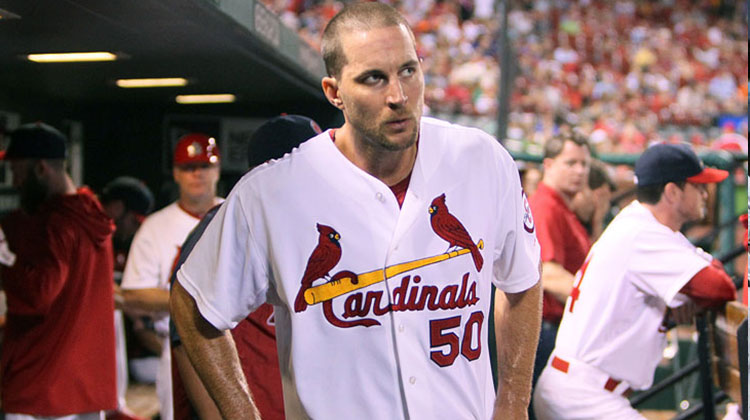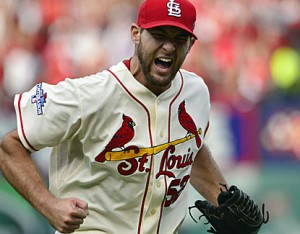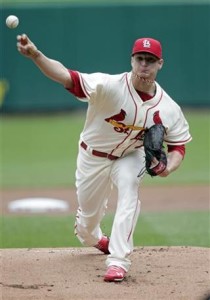 The St. Louis Cardinals had one of baseball’s better starting rotations in 2013. They finished the regular season with a team ERA of 3.42, and 13.6 fWAR. Only their division rival, the Pittsburgh Pirates, could top their team ground ball rate of 48.1 percent. Behind Adam Wainwright and rookie sensation Michael Wacha, the Cardinals rode strong pitching all the way to the World Series, where they fell at the hands of the Boston Red Sox.
The St. Louis Cardinals had one of baseball’s better starting rotations in 2013. They finished the regular season with a team ERA of 3.42, and 13.6 fWAR. Only their division rival, the Pittsburgh Pirates, could top their team ground ball rate of 48.1 percent. Behind Adam Wainwright and rookie sensation Michael Wacha, the Cardinals rode strong pitching all the way to the World Series, where they fell at the hands of the Boston Red Sox.
Looking to the 2014 season, which is mercifully fewer than six weeks away, the Cardinals appear to have a strong rotation once again. In fact, at this point they have more arms than starting spots.
The 32 year old Wainwright had a fantastic 2013 season. In his second year back from a Tommy John surgery that caused him to sit out the entire 2011 season, Wainwright threw a career-high 241.2 innings, totaling 6.2 fWAR, the third best mark in baseball. Over 34 starts he walked only 35 hitters, for a 3.7 percent rate. He added a four-seam fastball to a repertoire that already included a sinker, cutter, and devastating curveball.
 Just one year after being selected 19th overall, Wacha cracked the Cardinals big league roster. From there, he won his first four postseason starts, pitching to a miniscule 1.00 ERA in those outings. The young right-hander has two excellent weapons in a fastball that lives in the mid 90’s and a changeup that carried a 23.4 percent swinging strike rate.
Just one year after being selected 19th overall, Wacha cracked the Cardinals big league roster. From there, he won his first four postseason starts, pitching to a miniscule 1.00 ERA in those outings. The young right-hander has two excellent weapons in a fastball that lives in the mid 90’s and a changeup that carried a 23.4 percent swinging strike rate.
Fans certainly expect big things from Wacha in 2013. ZiPS and Steamer are more cautiously optimistic, projecting an ERA around 3.50. If he develops a reliable third pitch, he could beat those numbers easily. If not, he still looks to be solid, but it might be hard to live up to the sky-high expectations of some.
Lance Lynn has produced 6.0 fWAR over the last two seasons, and his career FIP is ten percent better than the league average. Left-handed hitters have generally had their way with the big righty, as they own a career .258/.369/.427 line against him. His fastball-heavy repertoire fared much better against righties who have hit just .234/.282/.346 against Lynn. Fortunately for Lynn, the NL Central isn’t stacked with left-handed bats and his success against righties is enough to make him a solid starting pitcher.
 Shelby Miller was conspicuously absent from postseason activities as the Cardinals placed him on their roster but parked him on the bench. The rookie faded hard in September, managing to strike out only 12.0 percent of hitters after being above 24 percent for most of the year. Like Lynn, he has issues with left-handed hitters, as he relies mainly on his fastball and curveball.
Shelby Miller was conspicuously absent from postseason activities as the Cardinals placed him on their roster but parked him on the bench. The rookie faded hard in September, managing to strike out only 12.0 percent of hitters after being above 24 percent for most of the year. Like Lynn, he has issues with left-handed hitters, as he relies mainly on his fastball and curveball.
Nevertheless, those two pitches are very good. ZiPS is quite high on Miller, projecting a 3.30 ERA over 175 innings for 3.2 fWAR, which would make him the second best starter on the staff. Steamer isn’t quite so optimistic, as it projects 1.6 fWAR.
Right now, Joe Kelly will battle with Jaime Garcia for the last spot in the Opening Day rotation. Kelly is a fireballer who posted a splendid 2.69 ERA in 124 innings spent between the bullpen and the rotation. His ERA didn’t match with his peripherals, as he authored strikeout and walk rates of 14.3 percent and 8.9 percent, respectively and his FIP was 10 percent worse than the league average.
Garcia was a solid starter between 2010-12. He pitched to a 3.36 ERA despite a fastball that sits in the high 80s. He’s a ground ball machine who generally avoids walks while missing a decent amount of bats. If he can bounce back from a shoulder surgery that ended his 2013 season, he could be a nice surprise for an already strong Cards rotation.
Besides those options, the Cardinals have Carlos Martinez, who showed off his electric stuff in the 2013 postseason, as he lit up the radar gun with 100 mph fastballs. His heater averaged 97 miles per hour in the regular season, and he kicked it up in the playoffs. He’s had some difficulties with left-handed hitters in his young career, as his changeup is currently quite raw.
The Cardinals will have an interesting decision with regards to Martinez. They can place him in the rotation, and trust that his stuff is good enough to let him learn on the job. Or, they can keep him in the pen and watch him fling fastballs by hitters. More likely they’ll let him develop as a starter in the minors while keeping his service clock from running.
Finally, dominant closer Trevor Rosenthal has repeatedly voiced his desire to start. At this point, it looks like that ship has sailed, at least for this season. Perhaps sometime the team needs and his wishes will align, and fans will get to see how Rosenthal’s high-octane fastball plays out when he has to go through a lineup multiple times.
The Cardinals are in a very enviable position in that they have an abundance of young, cost-controlled pitchers. If someone should go down with injury or pitch poorly, which almost inevitably happens, they have internal options to fill in. In the rare event of everything being rosy, the Cardinals have attractive trade chips, though they are in the similarly enviable position of not having many holes to fill.
